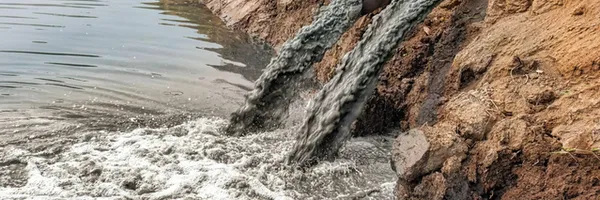Water contamination
Grade 8
Presentation
No video provided
Hypothesis
I think when I test my contaminated water with bacteria (pathogens) with my plant piece on the agar plate. I believe the pathogen with either start to grow bacteria like mold on the plant piece. Or the plant piece will slowly distingerate allowing the bacteria to take over the plant piece by covering it with pathogens.
Research
Research:
- WHO (World health organization) https://www.who.int/news-room/fact-sheets/detail/drinking-water:
- Improved water supply, sanitation, and water resources, boosts the country’s economy and contributes greatly to poverty.
- Over 2 billion people in 2021, who lived in water stressed countries, which is expected to worsen, due to climate change and population growth.
- Globally in 2022, at least 1.7 billion people had water sources contaminated with faeces. This is leading to microbial contamination, which leads to a great big problem on our drinking water source.
- Safe and sufficient water facilities that practice hygiene, is the key to prevent not only diarrhoeal diseases, but acute respiratory infections, and other pathogenic diseases.
- Contaminated microbiology drinking water can transmit diseases, such as cholera, diarrhoea, dysentery, typhoid and polio. Estimated to cause approximately 505 000 diarrhoeal deaths per year.
- In 2022 73% or the population (6 billion people) used a safe managed drinking service, free from contamination and located on the premises.
- The remaining 2.2 billion didn’t have clean water, which meant
- 1.5 billion people with basic water sources, have to walk to the nearest improved water location, which is around a 30 min walk.
- 292 with limited service, or an improved water source, which would require more than a 30 min walk to the nearest clean water source.
- 115 million people collecting untreated surface waters from ponds, lakes, rivers, and streams.
- Contaminated water and poor sanitation, transmits diseases like cholera, diarrhoea, dysentery, hepatitis A, typhoid, and polio. Inappropriately treated water and sanitation services which expose individuals to preventable health risks, harms people with those pathogenic diseases. Especially in health care centres, where staff and patients will be further exposed to infections and diseases when water, sanitation and hygiene are lacking, it will have higher risks.
- Infinity Learn Effects of Water Pollution on Human, Plants, and Animals:
- Polluted water negatively affects the breeding process for some aquatic species.
- Makes fish and plants deficient in their ability to regenerate and reproduce.
- Animals also fall to a variety of diseases due to drinking polluted water.
- Around 360 people per one lakh die in India, and over 50% of the patients get admitted to the hospital due to waterborne diseases.
- The situation in underdeveloped countries is worse, because over 80% of the patients are suffering from waterborne diseases, by drinking polluted water.
- Children often get very sick from drinking polluted water, sometimes they even die due to the intensity of the disease. It is estimated that 13 kids die per hour in India due to diarrhea from the contaminated water.
- Large amounts of chloride in drinking water, causes deformation of the spine, which causes it to go snaky and makes the teeth yellow. Hands and feet lose flexibility of their bones and body starts to deform.
- Large amounts of sulphide in the water, causes various respiratory diseases, water contaminated with urea increases intestinal order.
- If we continue to drink contaminated water, it leads to stomach disorders, and other diseases, like lumps in throats, tooth decay, etc.
- How do plants get affected by poor water?
- Slower growth
- Poor quality of the living plant
- Leads to gradual death of the plant
- High soluble salts damage the roots of the plant, interfering with water and nutrient uptake.
Graphs: A Review of the Status, Effects, Prevention, and Remediation of Groundwater Contamination for
- United Nations, https://www.un.org/en/global-issues/water:
- In July 2010, they recognized the importance of clean water and sanitation. They believe that every human should have the right to have access to about 50-100 litres of water per person, per day. The water should be safe, and the cost shouldn’t exceed over 3% of their household income. The water source must be within 1000 meters of the home, and the collection of the water shouldn’t exceed 30 minutes.
- “Water of Life” International Decade for Action 2005-2015, helped around 1.3 billion people in developing countries, gain access to clean drinking water. They grew the progress of sanitation as part of the effort to meet the Millennium Development Goals.
- Diarrhoea is estimated to cause 1.5 million child deaths per year, under the age of 5 in developing countries.
- Almost 10% of groundwaters are affected by unsustainable withdrawals that are high in water.
- Only 2.4% of the wastewater is reused, which is different per country.
- Almost a quarter of treated water gets lost from distribution.
What are the solutions?
- For agriculture, improve irrigation techniques through smart meters, and reuse treated water.
- Use practices like crop rotation, select water efficient crops, and enhance soil health.
- Agro-ecological methods such as agroforestry and permanent pastures.
- For Energy, move away from water intensive energy generation and focus on alternatives like wind, solar, and geothermal power.
- Conserve energy to save power
- Enhance energy efficiency
- Use advanced cooling technologies
- For infrastructure, on average 23% of treated water is lost in distribution in the EU.
- Fix leaking infrastructure
- Implement smart water meters
- Intergate water efficiency
- Find an affordable price for water, without incentivizing excessive water use.
- Target people who need support
- System applying the polluters to pay principle through extender producer responsibility.
Taking action: - Recycle water or fix a leak in the house, to stop waste of water, and save you money. You can make small changes in your lifestyle to reduce your water footprint.
- The freshwater is distributed unevenly due to the location of the countries, how rich the country is, and the connection you have with that country.
- China: Seen decrease of water about 50% per capita, availability between 1964-2020.
- John Hopkins Medicine Water, Sanitation, Hygiene, and Health | Johns Hopkins:
- In sub- Saharan Africa, an estimated about 200 million people are infected with parasitic worms that cause schistosomiasis. Released by freshwater snails, the worms penetrate the skin of people who bathe in water contaminated by human sewage.
- This disease can lead to kidney failure, bladder cancer, and infertility if untreated.
- Researchers from John Hopkins, went to the Peruvian Amazon, to collect samples of the water source. They will assess the sample, and see if the water the villagers are drinking is safe.
The Harvard Gazette Unsafe levels of toxic chemicals found in drinking water of 33 … :
- Widely use of industrial chemicals, are linked with different health problems like cancer, polyfluoroalkyl and perfluoroalkyl (PFAS)
- For many years, chemicals with unknown toxicities were allowed in our environment like PFAS, which is causing a disturbance to our environment.
- PFAS have been used in commercial products ranging from food wrappers, clothes, pots and pans . This is connected to cancer, hormone disruption, obesity, and high cholesterol.
- Drinking water has become one of the routes of exposing PFAS to people.
- The wastewater treatment plants discharge plants, which are unable to remove the PFAS from water by standard treatment methods. This could contaminate the groundwater. They could sludge the plants from regenerating, which is used as a fertilizer.
- PFAS have been detected by the EPA from 194 out of 4,864 water supplies in 33 starters across America. The drinking water from the 13 states was 75% of the detections: California, New Jersey, North Carolina, Alabama, Florida, Pennsylvania, Ohio, New York, Georgia, Minnesota, Arizona, Massachusetts, and Illinois.
- The Highest levels of PFAS were detected in watersheds near the military bases, industrial sites, and wastewater plants. These places may have had chemicals, and been found or have been used.
Asian Development Bank https://www.adb.org/features/water-sanitation-and-hygiene-healthy-asia-and-pacific:
- An ADB supported project improved rural water supply and sanitation facilities, including chlorination and wastewater drainage systems.
- Another thing to children's health is dengue is a spread of a specific type of mosquito that breeds in still water.
- There was a project, where the Cambodia government introduced Guppy fish and Lao People’s democratic republic with the support of WHO (World Health Organization) and ADB. This took place between 2009 and 2011, guppies eat larvae that grow into mosquitos. This resulted in a sharp decline in mosquito larvae in water storage tanks after the tiny fish were introduced.
- Drinking Water | US EPA U.S Environmental Protection Agency,
- Can cause health problems, gastrointestinal illnesses, nervous system or reproductive systems, and chronic diseases like cancer.
- Contaminants, which are heavy metals, oil spills, and pesticide can directly harm aquatic animals as well as land animals. For example, damage the gil, rot fin and tail. This can essentially lead to death.
- Water pollution can cause a lack of oxygen in the ocean. Certain types of pollutants like nitrogen and phosphorus, which can often be found in agricultural runoff, cause excessive amounts of algae growth.
- This creates dead zones, where fish and other animals suffocate due to the lack of oxygen. From decomposing algae.
- Certain types of contaminants can cause the growth of more fungi, bacteria and algae. This disturbs their habitat. Huge mats of algae and moss, can cause a disturbance of sunlight to come through.
- Industrial-scale farming uses a lot of agrochemicals, which causes a ginormous amount of water pollution in developing countries.
- Farmers are under more pressure for crops, making them move away from organic, and more sustainable farmer practices.
- This is causing health risk for themselves and the communities due to pesticides and excess amounts of nitrogen from fertilizers into rivers, streams and bodies of water.
- Plant cell technology: Plant Diseases Due to Contaminated Water-
- If water is contaminated, most likely the plants had contacts of diseases, viruses, or fungi.
- Plants that have been in contaminated water, can lead to discoloration, stunted growth, which potentially leads the plant to die
- If nitrogen filled water comes into contact with plants, the leaves may discolor, and you can become ill from consuming these plants. Most fertilizers have high amounts of nitrogen.
- E-coli, Hepatitis A, Listeria, and Salmonella, can harm plants too.
- Plants can get severely damage from being exposed to these two water molds ( Pythium, and Phytophthora)
- If use of recycled irrigation water, then greenhouse plants could be exposed to inoculum.
- Plants can be in contact with waterborne pathogens from run-offs, irrigation sources, or even soil. If recycled irrigation is used, then your greenhouse plants could be exposed to inoculum.
Variables
In my experiment the plants piece is a responding variable, because it is responding to the contaminated water. My water sample is an independent variable it doesn't change throughout the experiment, the plant piece depends on the responding or independent variable to see on how the two variable interact.
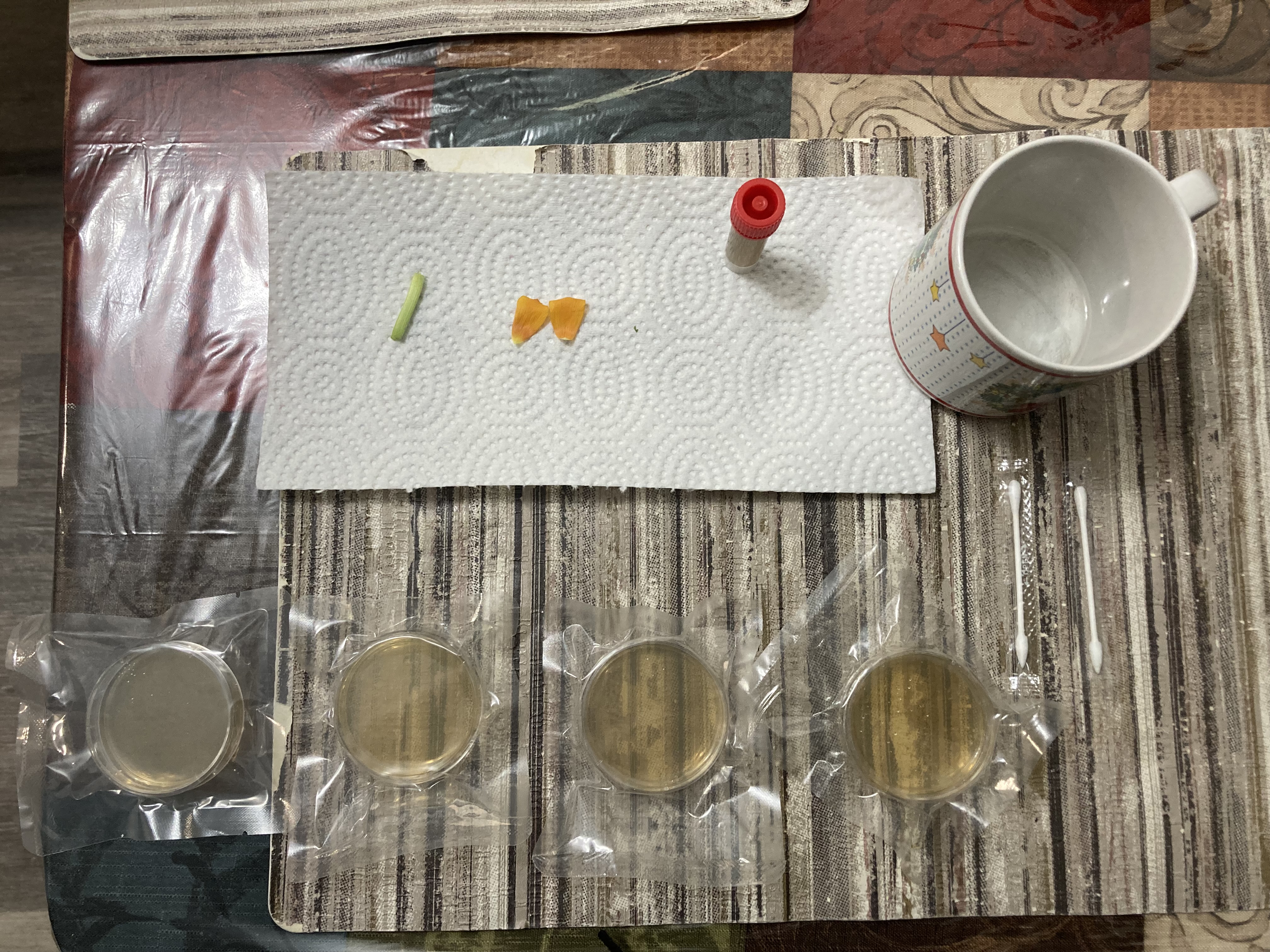
Procedure
Procedure with the plants
- First I collect my water samples from any body of water source
- I than prepare my work station by lighting a candle to keep the bacteria in the air and my enviornment from contaminated my work station.
- I take my Q-tip dip it in my contaminated water, rubbing the Q-tip across the agar plate in a zig zag motion.
- I added my plant piece to my agar plate with my water sample
- I attach the lid on, flipping it upside down to prevent condensation from dripping. Keeping it in room temperture and under my desk lamp.
- Waited 4-5 days to see bacterial growth on my agar plate
- Procedure for Testing Clean Water
- There are some ways to filter out your water without using a fancy filterization system I will be boiling my contaminated water between 1-3 mins or longer at higher altitudes.
- Having a lit up candle to prevent bacteria in the air to intefere in my experiment.
- I will than take a sterlize Q-tip and dip in the clean water, rubbing it on the agar plate in a zig zag positon.
- Store agar plate sample in a warm temperature (25 degrees celsius) or room temp ( 30 degrees celsius for 24-48 hours.
- If my agar plate doesn’t have any colonies of bacteria or mold it is good. However it’s not 100%. So for extra filterization add charcol for the chemicals, and chemical treatment like ( iodine or chlorine tables for viruses). I will not be doing this extra step but you should do this. My agar plate didn’t have colonies of bacteria or mold. But if you are drinking the water, do the last step.

Observations
Day 1:
- Agar plate 1: “Dirty Melted Snow Water”: It has a bunch of white spots that are starting to form colonies of bacteria. The bacteria spots are very spread out.
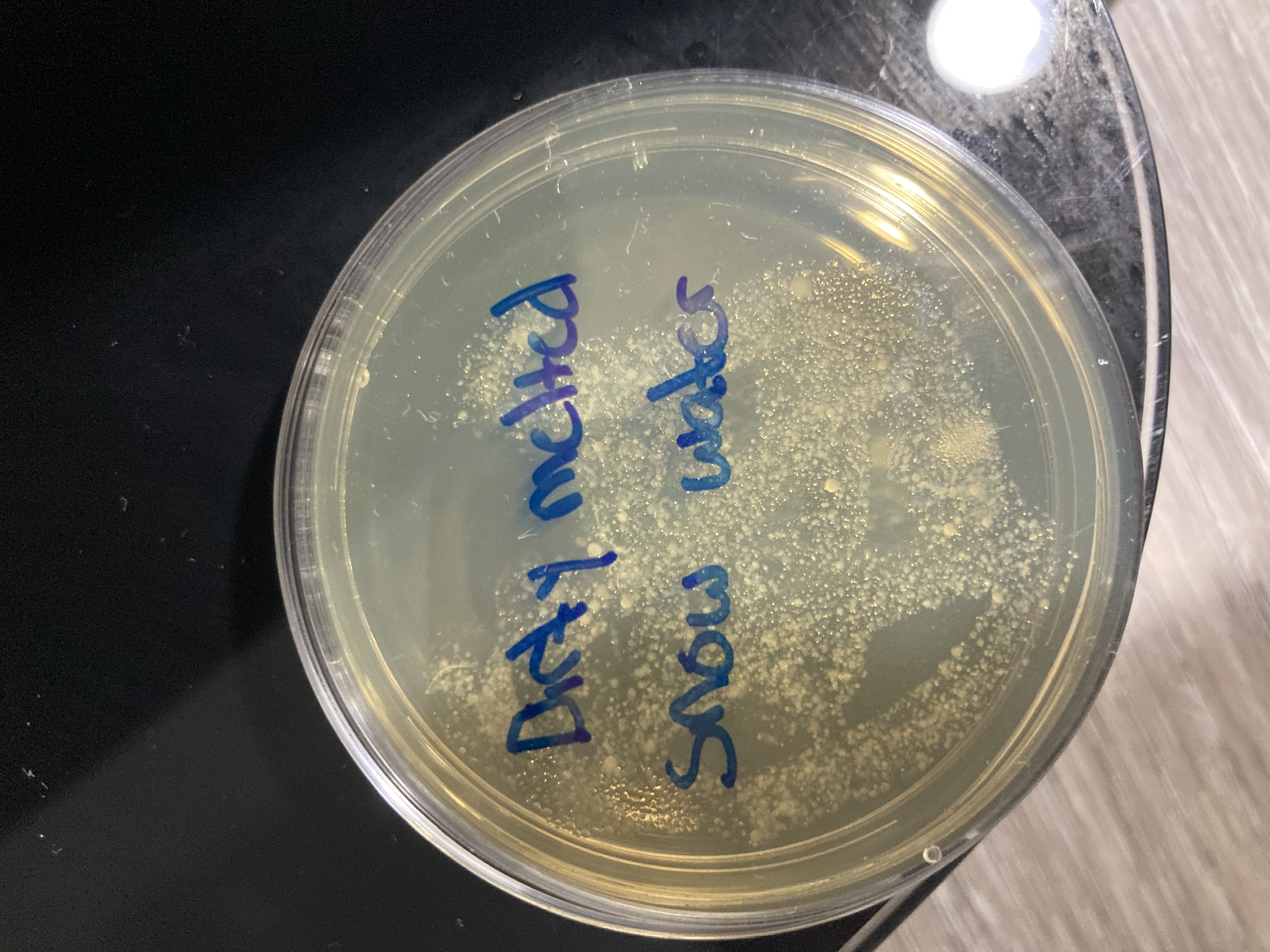
- Agar plate 2: “Flower Petal and dirty water”: This agar plate is forming a lot of tiny white particles, which are from the contaminated water. It’s also starting to form colonies. When you flip the agar plate upside down, I see white bacteria spots on the petal. It looks almost clear and similar to water droplets.
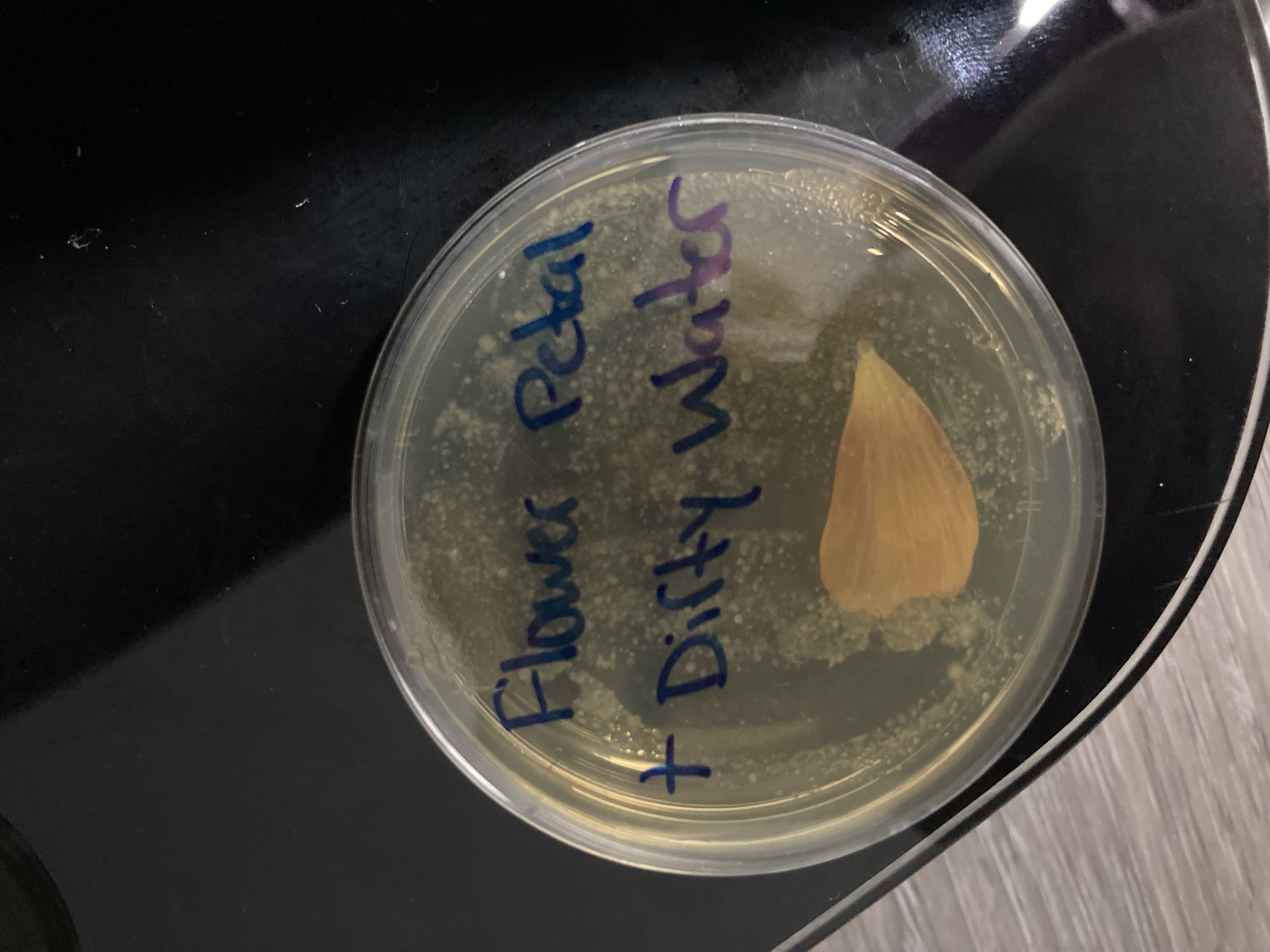
- Agar plate 3: “Stem and Dirty Water”: This agar plate has tiny white particles, which are spread out everywhere and one big white bacteria spot. The stem becomes very fuzzy, when you flip the agar plate right side up.
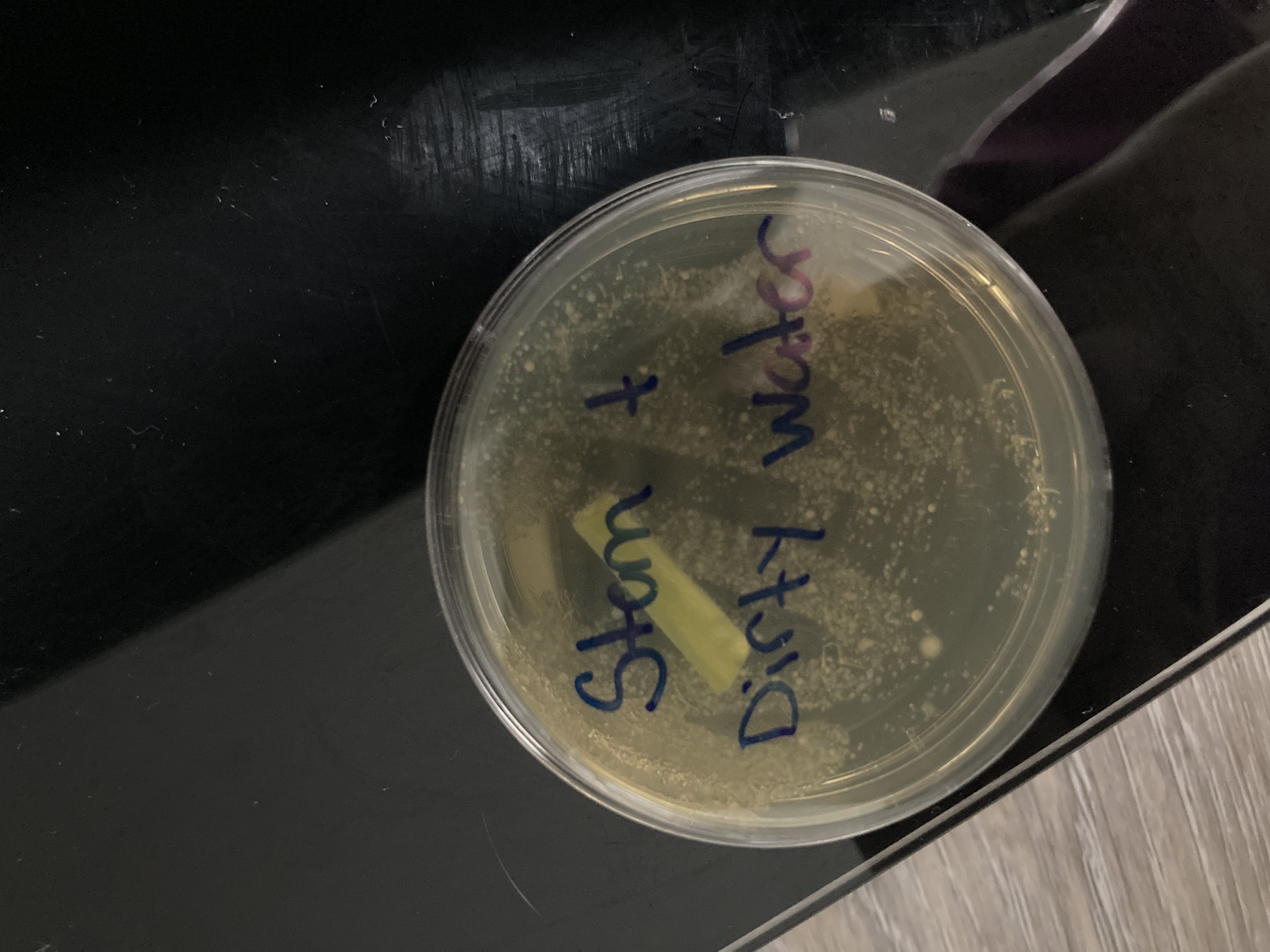
- Agar plate 4: “Clean Boil Water”: It hasn’t formed any bacteria or any colonies of bacteria.
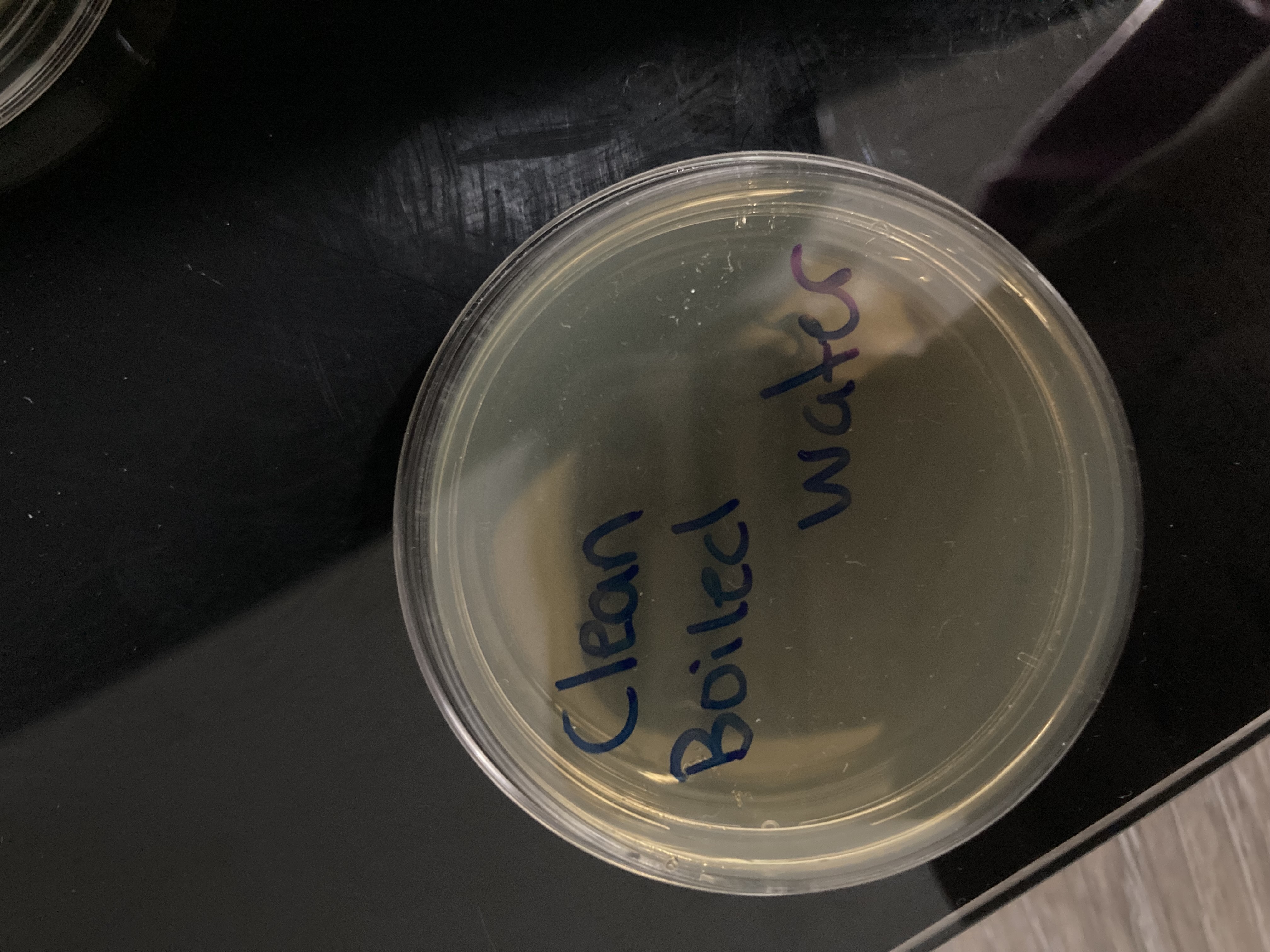
- Agar plate 5: “Clean Boil Water and Petal”: This agar plate hasn’t grown any bacterial spots or colonies.
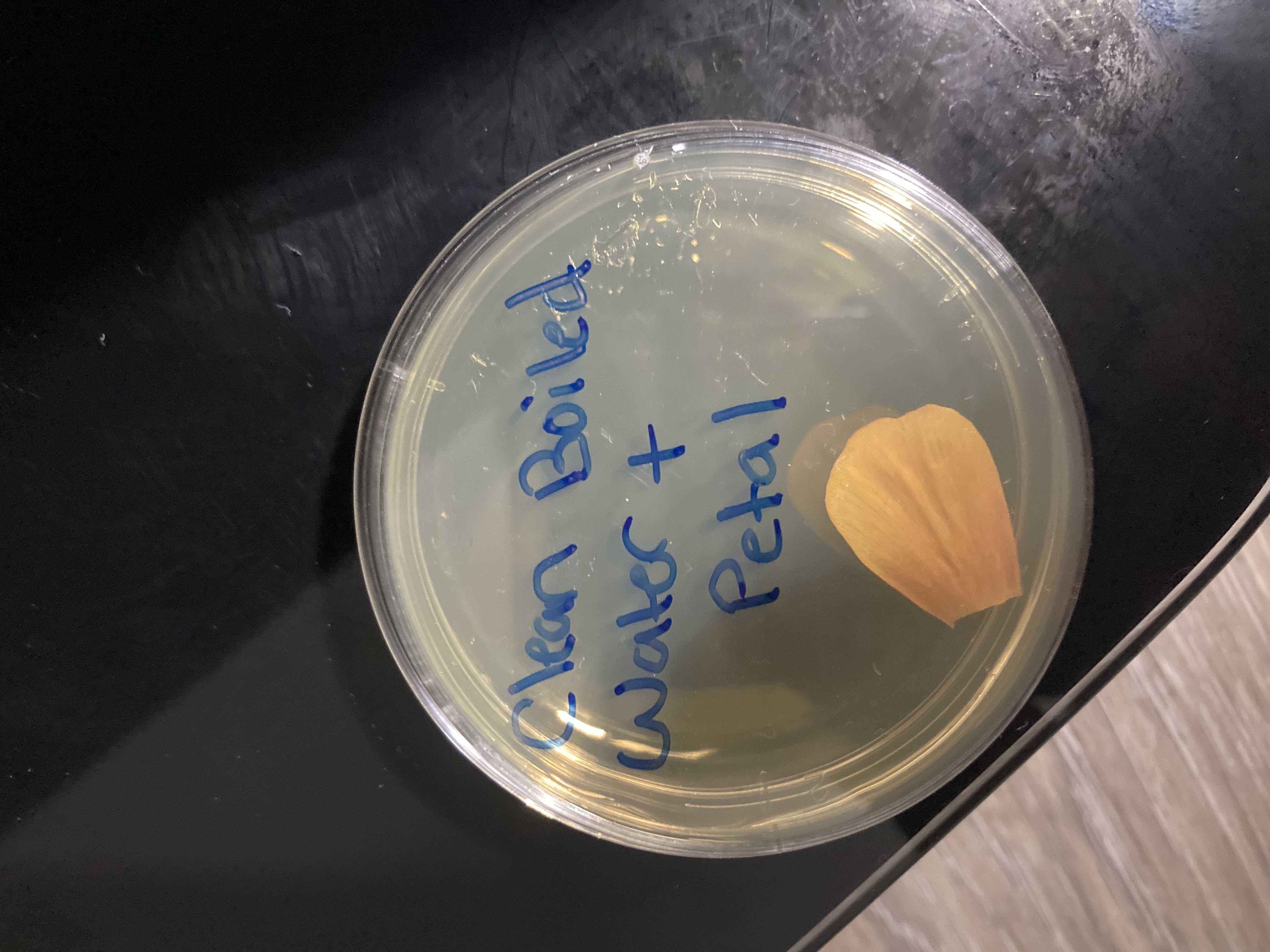
Analysis
Now what does the bacteria mean?
The bacteria in the water may mean-
- Staphylococcus- Round, shiny, white colony ( usually only on water, skin, or soil)
- Bacillus- Could be white fuzzy or look dry (I haven’t observe this bacteria on my agar plates)
- Yeast (Fungus)- Appears smooth, creamy, white colonies
Or yellow colonies such as-
- Micrococcus luteus- Harmless, round yellow bacteria, this may be found in water, soil, and air
- Staphylococcus aureus- This can be more yellowish, which is more concerning. This bacteria may be found in contaminated sources, which could be harmful
- Certain fungi- Certain types of mold or yeast may have yellow pigmentation.
Conclusion
In today’s World, contamination is a severe problem. However, this water crisis won’t be fully solved around the world for a while because of the development of other countries, and how they can financially support this crisis. It impacts all age groups transmitting various types of diseases. Sometimes people don’t have access to clean water and forced to use contaminated water instead.
According to WHO (World Health Organization),
- In 2022 73% or the population (6 billion people) used a safe managed drinking service, free from contamination and located on the premises.
- The remaining 2.2 billion didn’t have clean water, which meant
- 1.5 billion people with basic water sources, have to walk to the nearest improved water location, which is around a 30 min walk.
- 292 million people with limited service, or an improved water source, which would require more than a 30 min walk to the nearest clean water source.
- 115 million people collecting untreated surface waters from ponds, lakes, rivers, and streams.
This is just a glimpse of what other countries around the world have to face. There have been so many cases of microbial diseases in the water that are then transmitted in human bodies.
In conclusion water contamination is a burning problem, and won’t be fixed for a while. However, if we realize now and make a change, we can start to reduce contaminated water around the world.
Application
My project is about Water Contamination. All of my findings are based on the actual events that occurred in the real world. The experiment that I did, shows how the contaminated water impacts the plant piece, and how the independent and dependent variables interact with each other. If we look at the outcome of this experiment or the analogy, you can see how the bacteria possibly may interact and impact humans by visibly seeing it on the plant piece. Now obviously the plant piece may have different outcomes after the bacteria attacked it. But we can understand as humans how the bacteria impacts plant pieces and how they may target us, depending on our body type.
Sources Of Error
During my project, I believed I didn't make that many errors for my project itself and trifold. Time may be a big factor that I would like to mention. I could have used my time more wisely and use the time I had more efficiently. Especially during the end. However the project itself I believe I did my best.
Coming back to the time, I didn't have enough time to rehearse my presentation and work on my script. So during the presentation, the first time I presented I was at my best and my confidence wasn't the highest. If I had more time I would have felt better and more confident.
Next time I have to manage my time more efficiently, in order for me to practice on my presentation.
Citations
- Water Quality for Crop Production - UMass Extension:
- Effects of Water Pollution on Human, Plants, and Animals:
- https://www.who.int/news-room/fact-sheets/detail/drinking-water
- A Review of the Status, Effects, Prevention, and Remediation of Groundwater Contamination for
- https://www.un.org/en/global-issues/water
- https://environment.ec.europa.eu/topics/water/water-wise-eu/polluted-water_en
- https://datatopics.worldbank.org/sdgatlas/goal-6-clean-water-and-sanitation/?lang=en
- Water, Sanitation, Hygiene, and Health | Johns Hopkins
- Unsafe levels of toxic chemicals found in drinking water of 33 …
- https://www.adb.org/features/water-sanitation-and-hygiene-healthy-asia-and-pacific
- Canva
- Future Learn: Bacterial contamination: do-it-yourself water testing
- Drinking Water | US EPA
- https://www.aquaread.com/blog/impact-of-water-pollution-on-aquatic-life/
- https://www.greenpeace.org/africa/en/blogs/49015/what-are-the-causes-and-effects-of-water-pollution-in-africa/
- Plant Diseases Due to Contaminated Water
- ChatGPT
- https://www.sciencebuddies.org/science-fair-projects/references/interpreting-agar-plates
Acknowledgement
My parents and school teachers for guiding me through this project. I thank them

